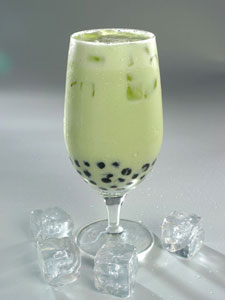Boba: Everything You Need to Know about Bubble Tea


First, there was ice tea. A simple enough drink made creative with a splash of fruit juice ice cubes or slices of fruit. This made it a relative of sangria, far removed from a simple glass of refreshment 'invented' on a hot day in 1904, amidst the World Expo in St. Louis.
With global cuisine seeping deeper and closer into the American culture, Thai tea became a sensation, a blend of ground black tea, coconut or condensed milk and sugar. A wonderful antidote to spicy foods.
Masala chai, India's take on tea with milk is now popular as well. It is often served chilled, which makes the pungent masala spices ever more delicious. And the drink a more substantial beverage to enjoy either alone or with food.
The most recent addition to the ice tea family is boba, also known as bubble tea. It was first developed in Taiwan where it is as ubiquitous as certain coffeehouses are in the U.S. My first boba taste experience came not at a Taiwanese restaurant, but a Vietnamese restaurant where gigantic 16mm balls of black gummy tapioca were plopped into a sickly sweet tea. It was the first tea experience that could be described as grainy. Out of my most sophisticated vocabulary came the only word that seemed apt: YUCK!
Cruising my local Japantown, however, I noticed that many restaurants were touting BOBA TEA in huge banners across their storefronts. And not one, not two, but four shops in a three-block radius were now completely dedicated to "boba tea."
Instead of just tea with tapioca balls (which are actually made from tapioca starch), these shops offer a mind-boggling menu of choices for what really seem to be "pudding in a cup," sweet, chewy tapioca balls floating in a milky tea that is refreshing and delicious. The Japanese have even cleverly designed oversized straws so one could literally suck up a tapioca ball through the straw and chew it for its pudding-like texture which I have now come to believe is what they SHOULD taste like.
The staff use a small-bowled ladle to scoop out a gigantic serving of the balls, kept cool in stainless steel trays. They place them into cups, then pour on the tea of your choice: black tea, green tea, jasmine tea, or an herbal honey tea. Like fruit? You can add mango, strawberry, plum, lemon, grape, green apple, orange, blueberry, peach and a slew of other flavors. Like a thicker drink? Get your boba blended for a milkshake-like consistency that's quite yummy and has, miraculously, no dairy and just a trace of fat. One more decision to make: You can have it hot or cold.
Another bubble in the menu is adding a tapioca bob balls to flavored or milk teas. The fruit flavored black or green teas seem a bit softened by the tapioca balls with little or no loss of the fruit flavor. The milk teas, however, seem to be an overkill, but, hey, can millions of boba lovers be wrong? Or, is it only me?
For someone who believes Dragonwell and Darjeeling are what tea is all about, the casualness, the color, taste, and texture of bubble teas may seem shocking or anathema. They are neither. What they are is a form of tea dessert, taking our favorite brew and expanding it into another part of the menu. And, the better the tea, like in every other food or drink category, the better your bubble tea will taste.
Teenagers adore it (and it's surely more exciting than another diet cola), it's a passable sweet for most diabetics and those of us on yet another weight-loss plan. But the real reason to sample bubble tea is that it's a different, light-hearted, totally unserious way to approach this age-old beverage. And whatever gets more people to think tea has got to be the best reason of all.
